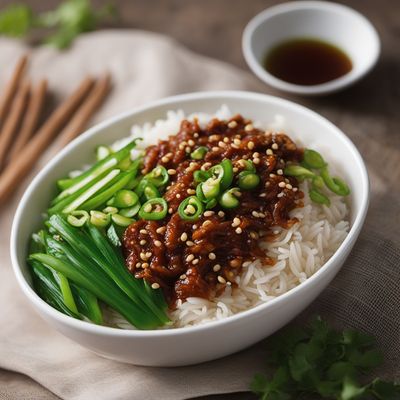
Recipe
Javanese-style Ssamjang
Spicy Peanut Ssamjang: A Javanese Twist on a Korean Classic
4.7 out of 5
Indulge in the vibrant flavors of Javanese cuisine with this unique twist on the traditional Korean dish, Ssamjang. This Javanese-style Ssamjang combines the rich and nutty taste of peanuts with a spicy kick, creating a delightful fusion of two culinary worlds.
Metadata
Preparation time
15 minutes
Cooking time
N/A
Total time
15 minutes
Yields
4 servings
Preparation difficulty
Easy
Suitable for
Vegetarian, Vegan, Gluten-free, Dairy-free, Nut-free
Allergens
Peanuts, Sesame
Not suitable for
Paleo, Keto, Low-carb, Soy-free, Egg-free
Ingredients
In this Javanese adaptation of Ssamjang, we replace the traditional Korean soybean paste with peanuts, giving the dip a distinct nutty flavor. Additionally, we incorporate Javanese chili peppers, which are known for their spiciness and unique taste. These modifications infuse the dish with the vibrant and bold flavors of Javanese cuisine, while still maintaining the essence of the original Korean dish. We alse have the original recipe for Ssamjang, so you can check it out.
-
1 cup (240g) roasted peanuts 1 cup (240g) roasted peanuts
-
3 Javanese chili peppers, deseeded and finely chopped 3 Javanese chili peppers, deseeded and finely chopped
-
3 cloves of garlic, minced 3 cloves of garlic, minced
-
2 tablespoons (30ml) kecap manis (sweet soy sauce) 2 tablespoons (30ml) kecap manis (sweet soy sauce)
-
1 tablespoon (15ml) tamarind juice 1 tablespoon (15ml) tamarind juice
-
1 tablespoon (15ml) lime juice 1 tablespoon (15ml) lime juice
-
1 teaspoon palm sugar 1 teaspoon palm sugar
-
1 teaspoon sesame oil 1 teaspoon sesame oil
-
1 teaspoon toasted sesame seeds 1 teaspoon toasted sesame seeds
-
Salt, to taste Salt, to taste
Nutrition
- Calories (kcal / KJ): 180 kcal / 753 KJ
- Fat (total, saturated): 14g, 2g
- Carbohydrates (total, sugars): 10g, 4g
- Protein: 7g
- Fiber: 3g
- Salt: 0.5g
Preparation
-
1.In a food processor, grind the roasted peanuts until they form a coarse paste.
-
2.In a mixing bowl, combine the ground peanuts, chopped Javanese chili peppers, minced garlic, kecap manis, tamarind juice, lime juice, palm sugar, sesame oil, and toasted sesame seeds.
-
3.Mix well until all the ingredients are thoroughly combined.
-
4.Season with salt to taste.
-
5.Transfer the Javanese-style Ssamjang to a serving bowl and garnish with additional toasted sesame seeds.
-
6.Serve as a dip with grilled meats, vegetables, or use as a spread for sandwiches.
Treat your ingredients with care...
- Peanuts — Make sure to use roasted peanuts for a richer flavor and smoother texture. If you prefer a chunkier dip, pulse the peanuts a few times instead of grinding them into a paste.
Tips & Tricks
- For a milder version, reduce the number of Javanese chili peppers or remove the seeds before chopping.
- Adjust the sweetness by adding more or less palm sugar according to your taste preference.
- Experiment with different types of roasted nuts, such as cashews or almonds, for a unique twist on the Javanese-style Ssamjang.
- Store any leftovers in an airtight container in the refrigerator for up to one week.
- Serve the dip at room temperature to allow the flavors to fully develop.
Serving advice
Serve the Javanese-style Ssamjang in a small bowl alongside a platter of grilled meats, vegetables, or as a condiment for rice dishes. Provide fresh lettuce leaves or cabbage leaves for wrapping the grilled items and dipping into the Ssamjang.
Presentation advice
Garnish the Javanese-style Ssamjang with a sprinkle of toasted sesame seeds and a few slices of Javanese chili peppers for an eye-catching presentation. Place the bowl on a wooden serving board or a traditional Javanese batik cloth to add a touch of authenticity to your presentation.
More recipes...
For Ssamjang
For Korean cuisine » Browse all

Wanjajeon - Korean Pan-Fried Meatballs
Savory Korean Meatballs: A Delightful Twist on Wanjajeon

Kongguksu - Creamy Soy Milk Noodle Soup
Silky Delight: Kongguksu - A Refreshing Korean Soy Milk Noodle Soup

Korean-style Crispy Kohli Bourbouristi
Kohli Bourbouristi: A Korean Twist on Greek Crispy Delight
More Korean cuisine dishes » Browse all

Dububap
Dububap is a traditional Korean dish made with rice, beans, and vegetables. It is usually served as a main course.

Wanja jorim
Korean meatballs with soy sauce
Wanja jorim is a Korean braised beef dish that is flavored with soy sauce, garlic, and ginger.

Myeolchi bokkeum
Spicy Stir-Fried Anchovies
Myeolchi bokkeum is a Korean side dish made with dried anchovies that are stir-fried in a sweet and savory sauce. It is a popular banchan (side...





